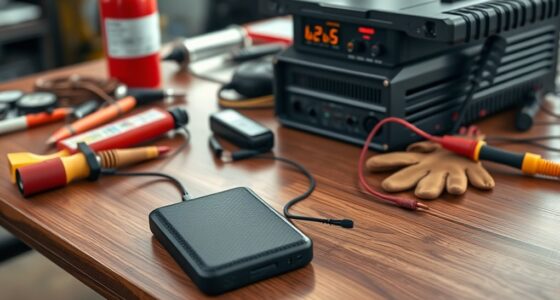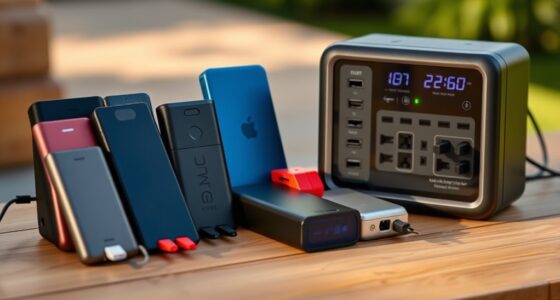When comparing power banks and power stations, you need to calculate their capacity in watt-hours (Wh) to understand how long they can power your devices. Convert mAh ratings to Wh based on voltage, then match that to your device’s energy needs. Don’t forget to take into account voltage, amperage, and charging efficiency. By doing these quick calculations, you’ll choose the right option—plus, you’ll discover more tips for maximizing your power sources.
Key Takeaways
- Calculate total energy needs in Wh to determine whether a power bank or station can meet device requirements.
- Consider voltage compatibility and safety margins to prevent damage and ensure proper device operation.
- Use capacity in Wh and efficiency rates to compare actual usable energy and runtime between options.
- Account for power output wattage and port types to ensure quick charging and proper device connection.
- Factor in device longevity, cycle life, and environmental impact when choosing between portable power banks and larger stations.
Understanding Capacity: Watt-Hours vs. Milliamp Hours
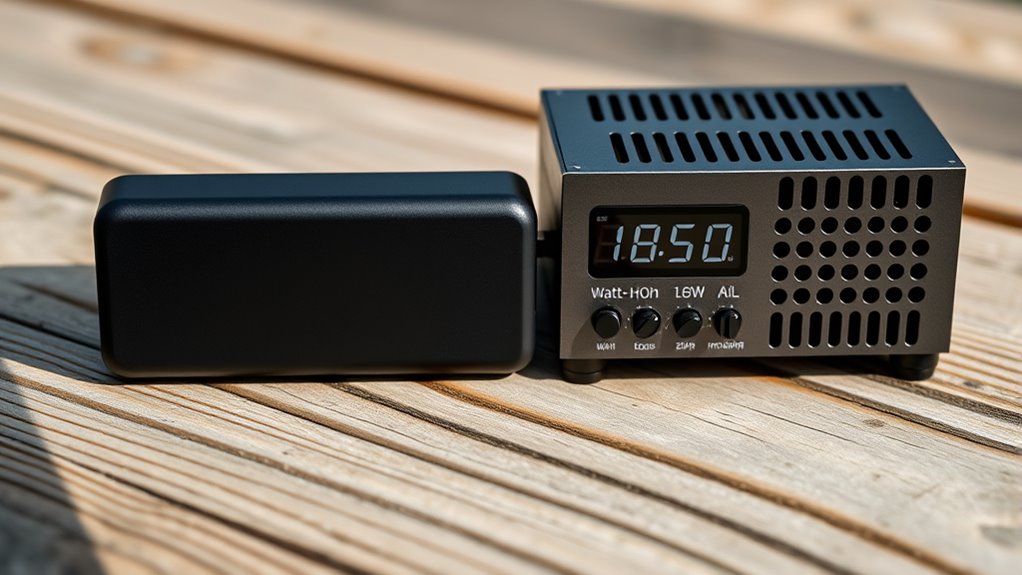
Understanding capacity is essential when comparing power banks and power stations, and it can be confusing because they use different units. Watt-hours (Wh) and milliamp-hours (mAh) measure energy but in different ways. Power stations typically list capacity in watt-hours, which reflects the total energy stored, taking into account voltage and battery chemistry. Power banks often use milliamp-hours, which depends on the battery’s voltage and energy density. Battery chemistry influences energy density, affecting how much power a battery can hold relative to its size. Higher energy density means more energy stored in a smaller, lighter battery. When comparing devices, understanding these differences helps you determine how long your device will run, depending on the battery’s chemistry and energy storage capacity. Additionally, knowing the battery chemistry can help you estimate the overall durability and performance of the power source.
Calculating Power Needs Based on Device Usage
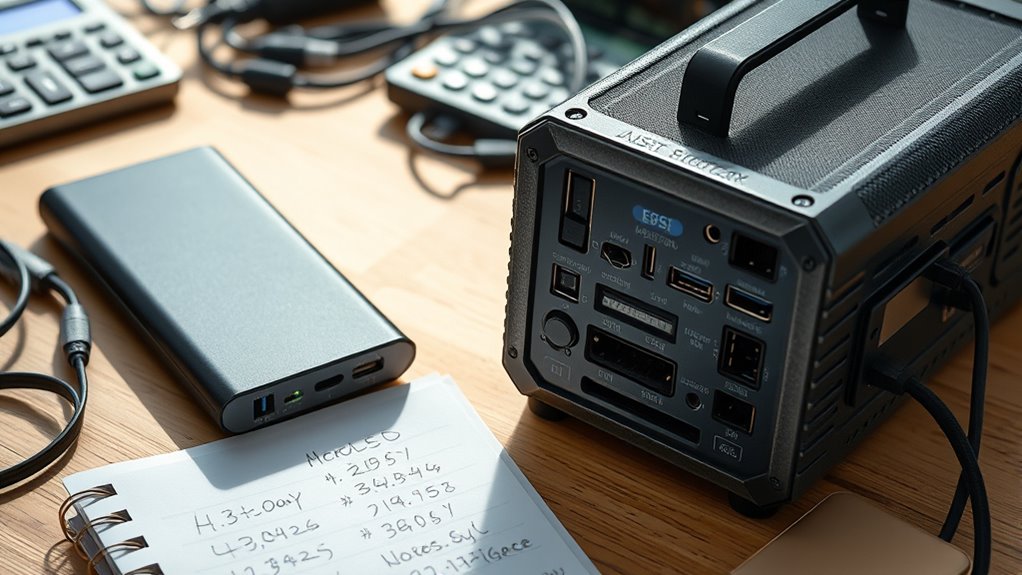
To select the right power source, you need to estimate how much power your devices use. By understanding your devices’ power consumption, you can match them to a power bank or station capacity. This helps guarantee your devices stay charged without overestimating or underestimating your needs.
Estimating Power Consumption
Estimating your power needs starts with understanding how much energy your devices consume during use. To do this accurately, check the device’s wattage or voltage and current ratings, usually found on labels or manuals. Consider how long you’ll use each device daily. Battery technology plays a role here; devices with higher energy density store more power in smaller sizes, affecting consumption estimates. For example, a device with a 10W power draw used for 5 hours consumes 50Wh of energy. Summing these values for all devices gives you the total energy requirement. Additionally, understanding the power output capabilities of your power source ensures it can handle your total load safely. Accurate calculations ensure you select a power bank or power station with sufficient capacity to meet your needs without overestimating. This approach helps optimize your choice between portable power options.
Matching Devices to Capacity
Matching your devices to the right power capacity involves calculating their total energy needs based on actual usage. First, determine each device’s power consumption in watt-hours (Wh) and add them up to find your total energy requirement. This helps you select a power bank or power station that aligns with your device’s needs without overloading or underperforming. Consider battery lifespan when choosing a device; higher-capacity units generally last longer and support more cycles. If you plan to use solar panels, check solar compatibility to ensure your power source can recharge efficiently. Proper matching ensures your devices stay powered during outages or outdoor adventures, maximizing efficiency and longevity while avoiding unnecessary expenses. Additionally, understanding the nutritional benefits of chia seeds can be helpful for maintaining overall health and well-being.
The Significance of Voltage and Amperage in Power Devices
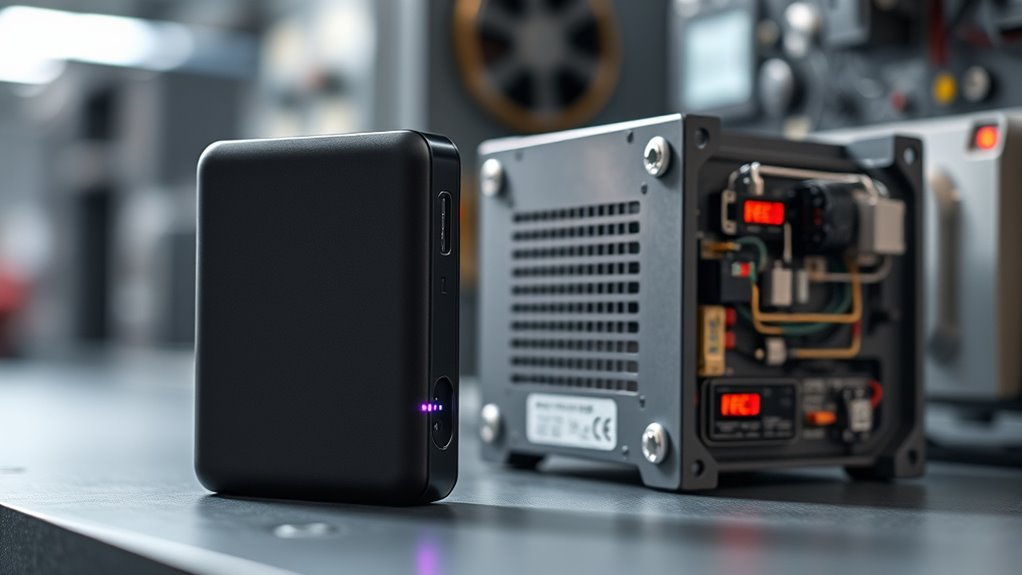
Understanding voltage is key because it guarantees if your device receives enough power without damage. Amperage affects how much current your device can draw, impacting overall performance. Following safe usage guidelines ensures you avoid risks and keep your devices operating smoothly. Additionally, using appropriate power management devices can help monitor and regulate projector bulb lifespan, preventing unexpected failures.
Voltage’s Impact on Devices
Voltage plays a crucial role in how well your devices perform and stay safe. If the voltage exceeds your device’s specified voltage, it can cause overheating, damage, or even failure. Proper voltage regulation guarantees your device receives a steady, appropriate level of voltage, preventing fluctuations that could harm it. Conversely, if the voltage is too low, your device may underperform or refuse to operate altogether. Understanding your device voltage requirements helps you choose power sources that deliver consistent, reliable power. Using a power bank or power station with mismatched voltage can lead to inefficiency or damage. Always verify that the voltage matches your device’s specifications to keep it running smoothly and safely. Additionally, considering lifestyle factors such as the environment where you use your devices can influence the importance of proper voltage regulation.
Amperage and Power Output
Amperage, combined with voltage, determines how much power a device can draw and use effectively. Higher amperage allows devices to charge faster, but it also impacts battery longevity and the number of charging cycles your power bank or station can handle over time. If the amperage is too high for your device, it may cause overheating or damage, reducing its lifespan. Conversely, too low amperage results in slow charging, which might be inconvenient but safer for your equipment. Understanding the relationship between voltage and amperage helps you choose the right power source to optimize performance and durability. Properly matching these factors guarantees your device operates efficiently without shortening its overall lifespan.
Safe Usage Guidelines
To guarantee safe and effective use of power banks and stations, it’s crucial to pay attention to their voltage and amperage ratings. Exceeding recommended levels can compromise battery safety and increase electrical hazards, risking damage to your devices or personal injury. Always check the manufacturer’s specifications before connecting devices, ensuring the power output matches your device’s requirements. Using incompatible or overpowered chargers can cause overheating or short circuits. Avoid attempting to modify or bypass safety features, as this can lead to dangerous situations. Properly managing voltage and amperage helps prevent electrical hazards and prolongs your device’s lifespan. Remember, respecting these ratings is key to safe, reliable power usage, protecting both your equipment and your well-being. Additionally, understanding power device safety principles can further reduce risks and enhance your overall experience.
Runtime Estimates: How Long Will Your Power Source Last?

Understanding how long your power source will last is essential when choosing between a power bank and a power station. Your device’s runtime depends on battery capacity, lifespan, and charging cycles. A power bank with a high mAh rating might last a few hours, while a power station with a larger capacity can power devices for days. Keep in mind that battery lifespan diminishes over time, affected by charging cycles. Here’s a quick overview:
| Power Source | Runtime Estimate | Key Considerations |
|---|---|---|
| Power Bank | 2-8 hours | Limited cycles, shorter lifespan |
| Power Station | 8-48 hours | More cycles, longer durability |
| Both | Varies by device | Usage impacts longevity |
Knowing these factors helps you plan effectively and avoid surprises. Additionally, paint sprayer accessories such as extension wands and specialized spray tips can improve your efficiency and finish quality when working on large or detailed projects.
Charging Speed: How Quickly Can Your Devices Refill?
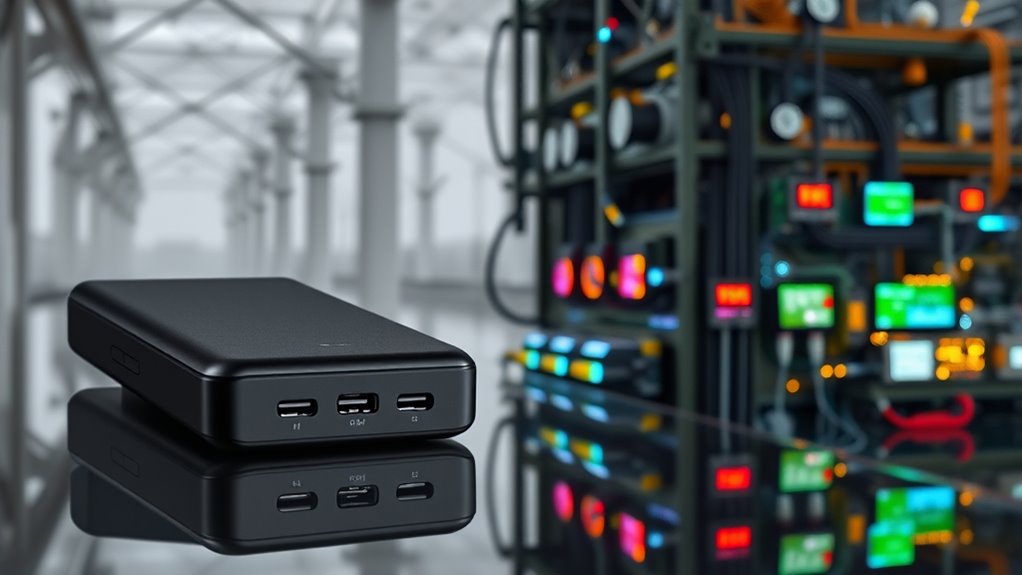
Your device’s charging speed depends on the compatibility of charging ports and the power output ratings of your power source. Higher power outputs typically mean faster refills, but not all devices can take advantage of them. To get the quickest charge, you’ll want to match your device’s charging time needs with the right power bank or station features. Additionally, understanding the art of Italian espresso can inspire you to create a cozy, stylish space that complements your tech setup at home.
Charging Port Compatibility
Charging port compatibility plays a crucial role in how quickly your devices can refill, as not all power banks and power stations support the same ports or charging standards. Your device’s charging speed depends on whether the port matches your device’s input and if it supports fast charging protocols like USB Power Delivery or QC. For example, some models include USB-C ports optimized for rapid recharge, especially when paired with a solar panel that supplies consistent power. Battery chemistry also influences charging efficiency, impacting how well devices refuel through specific ports. To maximize compatibility, check the port types and confirm they support your device’s charging standards. Additionally, understanding charging standards can help you choose the most efficient device for your needs.
Power Output Ratings
Power output ratings directly influence how fast your devices can recharge from a power bank or station. Higher wattage means quicker charging, especially when using a compatible solar panel for recharging on the go. Power stations with robust output ratings can handle larger devices or multiple gadgets simultaneously, reducing wait times. Battery chemistry also affects charging speed; lithium-ion batteries typically deliver faster, more consistent power compared to older chemistries. When evaluating your options, check the rated output in watts or amps—these figures indicate the maximum charging speed your device can experience. Keep in mind that the actual refill rate depends on both the power source’s output and your device’s input capacity, ensuring you match these for refrigeration cycle efficiency.
Device Charging Time
The speed at which your devices refill depends largely on the power output of your charger, whether it’s a power bank or a power station. Higher output means faster charging, but frequent rapid charging can accelerate battery degradation over time. This decline reduces the device’s capacity, impacting long-term usability. Additionally, faster charging cycles can contribute to environmental impact by increasing energy consumption and waste when batteries need replacing sooner. To optimize charging speed without harming your device or the environment, choose chargers with appropriate power ratings and avoid unnecessary rapid charges. Balancing speed with battery health is key to maintaining device longevity and minimizing environmental footprint. Remember, quick charging isn’t always better if it shortens your device’s lifespan.
Power Efficiency: Recognizing Losses and Waste
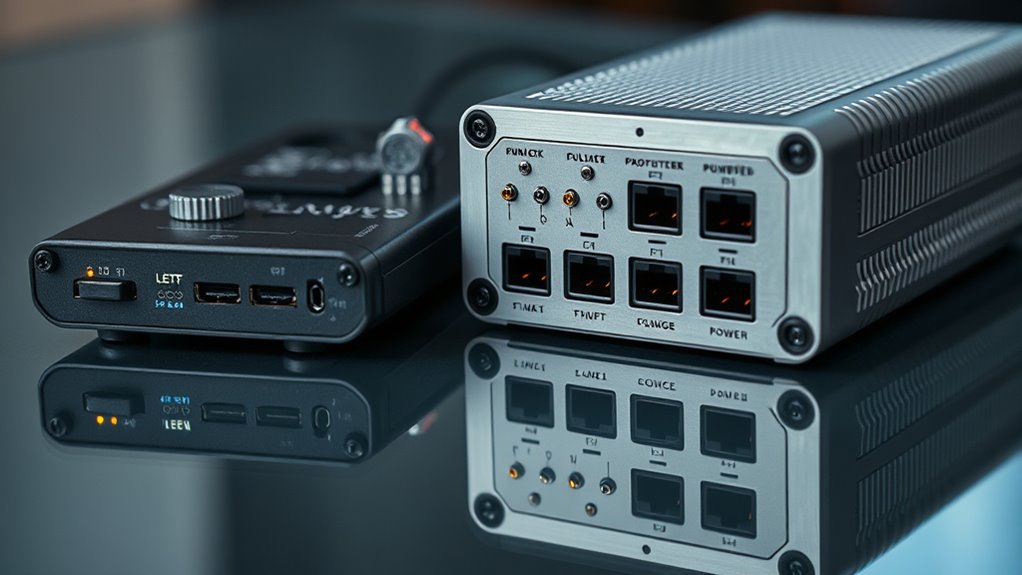
Understanding where energy gets lost or wasted is essential when comparing power banks and power stations. Losses often occur during energy transfer, especially when charging devices or converting stored energy. For example, a solar panel captures sunlight and converts it into usable power, but some energy is lost as heat during this process. Similarly, energy storage systems aren’t 100% efficient; they lose a small percentage of energy during charging and discharging cycles. When evaluating power stations, consider the efficiency of their inverters and converters, which can introduce additional waste. Recognizing these losses helps you make smarter choices, ensuring you select systems with minimal waste, ultimately maximizing the usable energy and prolonging device operation.
Weight and Portability: Balancing Power and Convenience
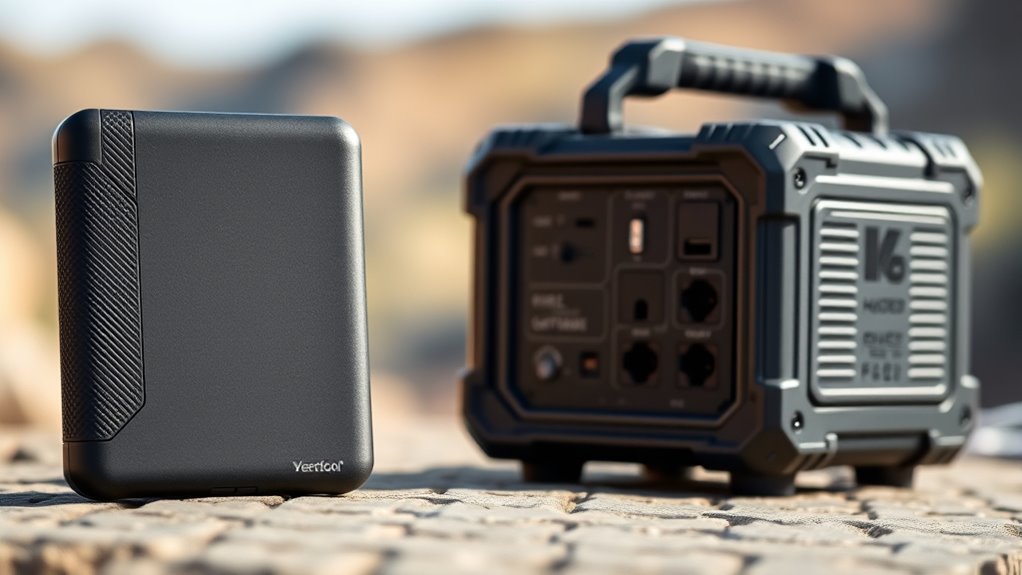
While both power banks and power stations aim to keep your devices charged, their weight and size substantially impact how easy they are to carry around. A lightweight power bank with compact design ergonomics lets you stay mobile without hassle. Conversely, power stations often pack more power but tend to be bulkier, making portability a challenge. The choice depends on your needs: a smaller device suits quick trips, while a heavier station is better for extended off-grid use. Battery chemistry influences weight—lithium-ion batteries tend to be lighter and more compact. Consider how the design ergonomics balance power capacity with ease of transport.
- Feel confident carrying your device effortlessly on adventures
- Enjoy quick access without bulky loads
- Feel empowered by choosing the right power solution for your lifestyle
Cost Analysis: Comparing Value Over Time
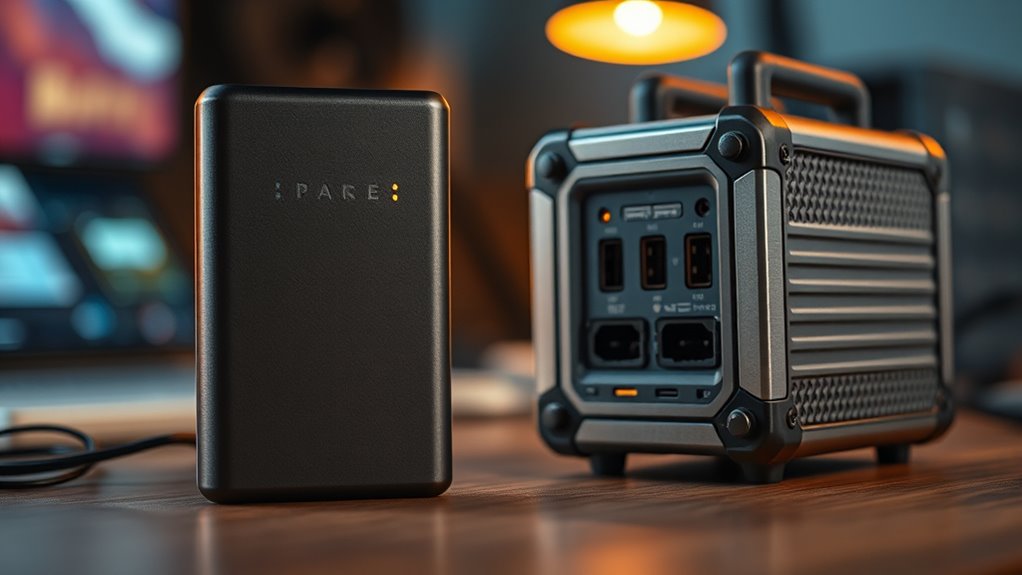
When evaluating the long-term value of power banks versus power stations, it’s important to contemplate their initial costs and how those expenses translate over time. Power banks typically have a lower upfront price but may require more frequent replacements due to limited battery longevity, increasing long-term costs. Power stations, while initially more expensive, often feature more durable batteries that last longer, reducing replacement frequency. Consider the environmental impact as well—long-lasting batteries generate less waste and have a smaller ecological footprint. Over time, investing in a power station could prove more economical and eco-friendly, especially if you need consistent, reliable power. Balancing initial investment with battery longevity and environmental concerns helps you make a smarter, more sustainable choice.
Safety Margins: Planning for Peak Power Demands

Planning for peak power demands is essential to guarantee your device or system remains dependable during sudden surges. By incorporating proper safety margins, you prevent overloads and protect your battery management system from damage. Always factor in extra capacity to handle unexpected spikes, ensuring safety protocols are in place. This proactive approach minimizes downtime and extends the lifespan of your power source. Recognize the importance of designing with a buffer to avoid risking your equipment’s performance.
Planning for peak power ensures reliability, safety, and longer equipment lifespan during unexpected surges.
- Feel confident knowing your setup can handle the unexpected.
- Protect your investment with thoughtful safety margins.
- Maintain peace of mind during critical moments.
Compatibility and Connector Types: Ensuring Proper Fit
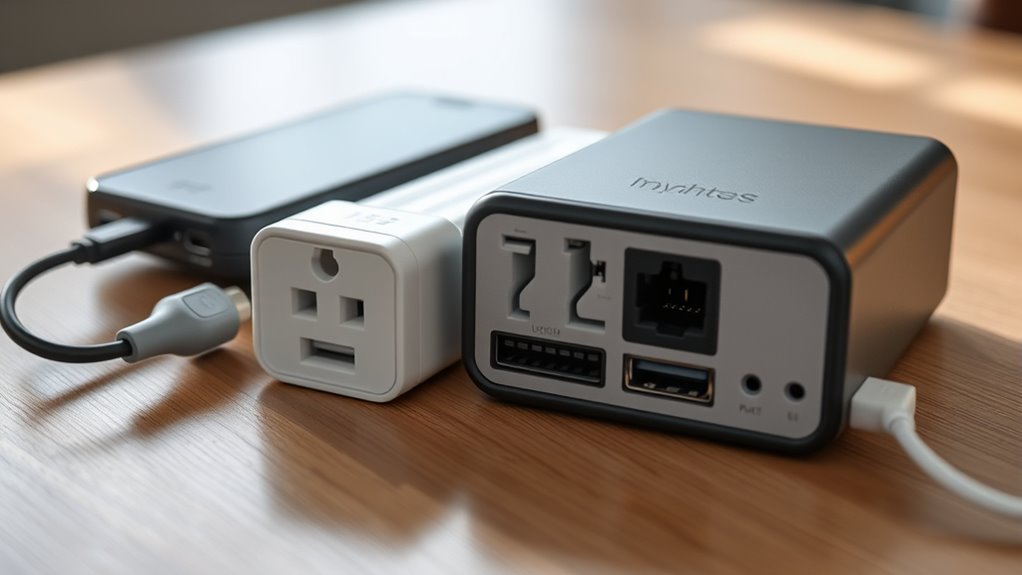
Ensuring compatibility and matching connector types is vital to guarantee your power source functions seamlessly with your devices. You need to check connector standards to ensure your power bank or station supports the right input and output ports. Port compatibility is essential; using incompatible connectors can prevent charging or damage your devices. Many power stations and banks now feature multiple connector types, such as USB-C, AC outlets, or DC ports, so verify that your device’s plug matches the available ports. Keep in mind that even if the connector physically fits, it must meet the correct voltage and current standards. By confirming connector standards and port compatibility beforehand, you avoid connection issues and ensure a proper fit, enhancing safety and efficiency during use.
Frequently Asked Questions
How Do Temperature Conditions Affect Power Bank and Station Performance?
Temperature conditions considerably influence your power bank and station performance through thermal effects. When it’s too hot or cold, their efficiency drops, and battery life shortens. You should guarantee proper temperature regulation by storing and using devices within recommended ranges. Extreme temperatures cause thermal effects that strain the battery, reducing capacity and lifespan. Monitoring and controlling the environment helps maintain ideal performance and extends your device’s longevity.
What Maintenance Routines Are Recommended for Long-Term Use?
Did you know that proper maintenance can extend your power station’s lifespan by up to 50%? To keep it in top shape, regularly perform battery calibration by fully draining and recharging it. Also, follow good storage practices: keep your device in a cool, dry place and avoid leaving it at full charge for long periods. These routines guarantee reliable performance and longevity for your power bank or station.
Are There Environmental Considerations When Choosing Power Sources?
When choosing power sources, consider environmental factors like solar panel efficiency and recyclable battery materials. Opt for solar panels with high efficiency to reduce your carbon footprint and reliance on non-renewable energy. Additionally, select devices with recyclable batteries to minimize waste and environmental impact. By prioritizing these aspects, you help promote sustainability and guarantee your power usage aligns with eco-friendly practices.
How Do Battery Lifespan and Cycle Count Impact Device Reliability?
Battery lifespan and cycle count directly impact your device’s reliability because battery degradation reduces capacity over time. As you cycle your battery, it wears down, meaning fewer charges and less performance. To maximize lifespan, you should practice cycle optimization by avoiding deep discharges and excessive charging. This helps maintain battery health longer, ensuring your device stays dependable and functional, even after many uses.
Can Power Stations Support Multiple Devices Simultaneously Effectively?
You might think power stations can’t handle multiple devices effectively, but they often do, thanks to their high capacity. Most models support device compatibility and can charge several gadgets at once without sacrificing charging speed. However, the effectiveness depends on the station’s output ports and wattage. When choosing, look for stations with multiple ports and sufficient power to make certain all your devices charge quickly and efficiently.
Conclusion
Choosing between power banks and power stations isn’t just about capacity—it’s about balancing portability with power. While a lightweight power bank offers convenience, it might fall short during peak demands. Conversely, a larger power station provides sustained energy but sacrifices mobility. Consider your needs carefully; sometimes, less is more, but other times, more is necessary. Ultimately, the right choice depends on how you prioritize power, portability, and peace of mind.


